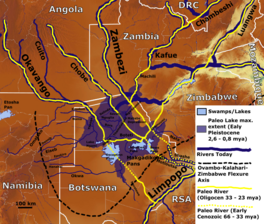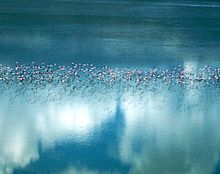| Lake Makgadikgadi | |
|---|---|
 The extent of the former Lake Makgadikgadi. | |
| Location | Kalahari Desert in Botswana |
| Coordinates | 20°43′0″S 24°57′3″E / 20.71667°S 24.95083°E |
| Basin countries | Botswana |
| Average depth | 30 metres (98 ft) |

Lake Makgadikgadi (Setswana: Letsha la Makgadikgadi, [lɪt͜sʰa la makχʰadiˈkχʰaːdi]) was a paleolake that existed in what is now the Kalahari Desert in Botswana from 2,000,000 years BP to 10,000 years BP. It may have once covered an area of from 80,000 to 275,000 km2 (30,888 to 106,178 sq mi) and was 30 metres (98 ft) deep.[1] The Okavango, Upper Zambezi, and Cuando rivers once all emptied into the lake. Its remains are seen in the Makgadikgadi salt pans, one of the largest salt pans in the world.
DNA research suggests the lake region is the homeland of Homo sapiens, where humans first evolved as a distinct species about 200,000 years ago, before expanding to other parts of Africa about 70,000 years later.[2][3]
- ^ "Makgadikgadi Salt Pans". earthobservatory.nasa.gov. 2018-07-06. Retrieved 2018-08-16.
- ^ Michael Irving (October 28, 2019). "DNA study claims human "homeland" was a southern African wetland". New Atlas. Retrieved October 28, 2019.
- ^ Cite error: The named reference
:nature2019was invoked but never defined (see the help page).

